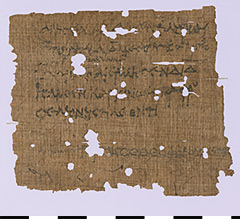BKT X 29 (P. 11831)
This piece shows the earliest preserved Greek horoscope on papyrus. The text mostly consists of abbreviations and its five lines were written in dark ink on a small, rectangular sheet of papyrus. Based on the mentioned celestial bodies and their zodiacal position the text can be dated to the 4th or 5th June 29 BC. A line of an earlier inscription on the lower part of the sheet shows that the papyrus has been reused.
Personal horoscopes became common after the idea became established in the 1st century BC that there was a connection between the movements of heavenly bodies and people’s fates. They remained popular until the end of the 4th century AD. Though horoscopes could vary in length, most of them followed the same formula: They start with an introduction stating the name of the individual for whom the horoscope is being issued, followed by the date and time of birth. Here they name the regnal year, the Egyptian month and day, and the hour of the day or night. Furthermore, the five planets that were known in ancient times and their position in the zodiac signs are listed, as well as the position of the sun, the moon and the ascendant.
Our piece however shows some deviations from this pattern. For one thing, it is missing an introduction — thus naming neither a certain individual nor a date of birth. For another thing, the planets are not, as usual, listed according to their distance to earth but (apart from the mention of the ascendant and midheaven) following the zodiac signs. This order only became common in the 2nd century AD.
Though the use of horoscopes was astrological in nature, their form was purely astronomical – the astrological interpretation was not recorded in writing.



